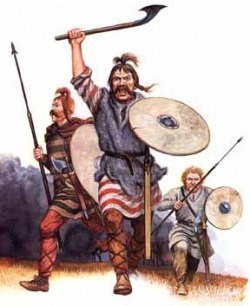Fries War

The war the Frisians fought against the Franks was the first (and, honestly, the last) time the Frisians were players on the continental scene. Although small conflicts started in the early 7th century, and continued through the end of the 8th century, the most important events were between 716 and 734. Through all the twists and intrigues of the battle, a pattern emerged—one empire takes land from another empire and forces its religion upon them. This lasts until the king of the conquering empire dies. Then the leader of the other empire takes back the conquered lands, and imposes his religion. Then that leader dies, and the process repeats…
The first permutation of the pattern happened in 630. The Frankish king Dagobert I, in an attempt to Christianize the notoriously pagan Frisians, seized the outer lowlands and built a church in Utrecht, a town in modern day southern Netherlands. Dagobert held the territory until his death in 650, at which the Frisians promptly took back their territory, drove all the Christians out, and made Utrecht the center of their once-again pagan government.
The next major conflict was in 690. It was between King Radbod of Frisia, and the Frankish Pepin of Herstal, mayor of the palace (for the record, “mayor of the palace” was a title approximating duke. They were powerful nobles who in some cases, as with Charles Martel, were the de-facto rulers). Although Radbod would go on to become perhaps Frisia’s greatest King, he was defeated by Pepin at the battle of Dorestad. The Franks went on to reclaim Utrecht and many other lowland territories, and forced the marriage of Pepin’s son with Redbod’s daughter in 711. I’m sure the wedding reception was awkward.
For the next couple decades, Frisia’s influence declined. But all of this changed in the year 714.
The first permutation of the pattern happened in 630. The Frankish king Dagobert I, in an attempt to Christianize the notoriously pagan Frisians, seized the outer lowlands and built a church in Utrecht, a town in modern day southern Netherlands. Dagobert held the territory until his death in 650, at which the Frisians promptly took back their territory, drove all the Christians out, and made Utrecht the center of their once-again pagan government.
The next major conflict was in 690. It was between King Radbod of Frisia, and the Frankish Pepin of Herstal, mayor of the palace (for the record, “mayor of the palace” was a title approximating duke. They were powerful nobles who in some cases, as with Charles Martel, were the de-facto rulers). Although Radbod would go on to become perhaps Frisia’s greatest King, he was defeated by Pepin at the battle of Dorestad. The Franks went on to reclaim Utrecht and many other lowland territories, and forced the marriage of Pepin’s son with Redbod’s daughter in 711. I’m sure the wedding reception was awkward.
For the next couple decades, Frisia’s influence declined. But all of this changed in the year 714.
